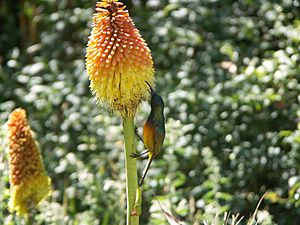Endemism facts for kids

Endemism is a word used in ecology. It means that a plant or animal lives only in one special place. This place could be a single island, a certain type of habitat, or even a country. For example, many kinds of lemurs live only on the island of Madagascar. They are endemic to Madagascar.
There are two main types of endemism. Paleoendemism means a species used to live in a large area. Now, it only lives in a much smaller area. Neoendemism means a species has appeared recently. It is closely related to another species, or it formed after two different species mixed. This new species is now seen as its own kind. This often happens with plants.
The opposite of endemism is a cosmopolitan distribution. This means a species lives in many different places around the world.
Contents
Why are some places special for endemic species?
Endemic species often appear on islands. This is because islands are cut off from other places. Good examples are the Hawaiian Islands, the Galápagos Islands, and Socotra. Endemism can also happen in areas that are separated from similar places. This includes the high lands of Ethiopia or large bodies of water like Lake Baikal.
Why are endemic species in danger?
Endemic plants and animals can easily become endangered or even extinct. This is because they live in such a small area. They are also easily hurt by human actions. One big problem is when new organisms are brought into their home. These are called introduced species.
For example, when people first settled Bermuda in the 1600s, there were millions of Bermuda petrels. There were also many "Bermuda cedars" (which are actually juniper trees). By the end of that century, people thought the petrels were gone. The cedars were already fewer due to centuries of shipbuilding. Then, in the 1900s, a parasite was brought in. It almost wiped out the cedars. Today, both the petrels and cedars are very rare. Many other species native to Bermuda are also rare.
Endemic organisms are not the same as indigenous organisms. An indigenous species is native to a place. But it might also be native to other places. An introduced species is one that does not naturally belong in a certain area.
Special places with many endemic plants
The World Wildlife Fund studies nature. They say these places have the most endemic plants:
- Fynbos in the Cape flower region (South Africa)
- Hawaiian tropical dry forests (United States)
- Hawaiian tropical rainforests (United States)
- Kwongan heathlands (Australia)
- Madagascar dry deciduous forests (Madagascar)
- Madagascar lowland forests (Madagascar)
- New Caledonia dry forests (New Caledonia)
- New Caledonia rain forests (New Caledonia)
- Sierra Madre de Oaxaca pine-oak forests (Mexico)
- Sierra Madre del Sur pine-oak forests (Guatemala)
- Luzon montane rainforests (Philippines)
- Luzon rain forests (Philippines)
- Luzon tropical pine forests (Philippines)
- Mindanao montane rain forests (Philippines)
- Mindanao-Eastern Visayas rain forests (Philippines)
- Palawan rain forests (Philippines)
What threatens these special places?
These special ecosystems are facing many dangers. Some of the main threats are:
- Large scale logging operations, which cut down many trees.
- Slash-and-burn farming. This is when forests are cut down and burned to clear land.
- Destroying habitats or plants. This puts endemic species in danger.
Images for kids
-
Bicolored frog (Clinotarsus curtipes) lives only in the Western Ghats of India.
-
Montezuma Well in Arizona has at least five species found only there.
-
Chorus cicada (Amphipsalta zelandica), a species found only in New Zealand.
See also
 In Spanish: Endemismo para niños
In Spanish: Endemismo para niños







